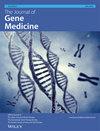The suppression of OTUD7B by miR-491-5p enhances the ubiquitination of VEGFA to suppress vascular mimicry in non-small cell lung cancer
Abstract
Background
Non-small cell lung cancer (NSCLC) is the main type of lung cancer with high morbidity and mortality. Vascular mimicry (VM), a distinct microcirculation model in tumors that differs from classical angiogenesis, is strongly associated with poor clinical outcomes in cancer patients. miR-491-5p has been reported to prevent NSCLC progression, including proliferation, metastasis, and angiogenesis. However, the effect and mechanism of miR-491-5p on VM have not been studied in NSCLC.
Methods
The expression of miR-491-5p was detected by quantitative reverse transcription PCR (qPCR) and fluorescence in situ hybridization (FISH). Cell counting kit-8 (CCK-8) and 5-ethynyl-2′-deoxyuridine (EdU) staining assays were used to examine cell growth. Tube formation assay was used to assess VM in NSCLC cells. Immunohistochemistry (IHC) and western blot were performed to detect protein expression. Immunoprecipitation was used to confirm the interaction between OTU deubiquitinase 7B (OTUD7B) and vascular endothelial growth factor A (VEGFA), and the level of ubiquitinated VEGFA. A nude mouse tumorigenesis model was used to evaluate the carcinogenic capacity of NSCLC cells in vivo. Luciferase reporter assay was used to identify the potential target of miR-491-5p.
Results
MiR-491-5p was found downregulated in NSCLC tissues, and miR-491-5p deficiency was strongly associated with angiogenesis. miR-491-5p mimics suppressed cell viability, migration, and VM. Conversely, an inhibitor of miR-491-5p had the opposite effect. OTUD7B, a deubiquitinase, was identified as a downstream target of miR-491-5p. A luciferase reporter assay indicated that miR-491-5p directly binds to the 3′UTR of OTUD7B. Moreover, mimics of miR-491-5p caused a significant reduction in the OTUD7B protein in NSCLC cells, and an inhibitor of miR-491-5p stabilized the OTUD7B protein. In addition, overexpression of OTUD7B promoted cell proliferation, migration, and VM, similar to the effects of an inhibitor of miR-491-5p. Further exploration revealed that OTUD7B interacts with VEGFA and that the miR-491-5p-OTUD7B axis modulates the ubiquitination of VEGFA. The rescue experiment indicated that OTUD7B compromised the inhibitory effects of miR-491-5p on the cellular function of NSCLC cells.
Conclusions
Overall, our study first proved that miR-491-5p impedes VM by suppressing OUTD7B and promoting the ubiquitination of VEGFA. The miR-491-5p/OTUD7B axis may be a novel target for antiangiogenic therapy in NSCLC.


 求助内容:
求助内容: 应助结果提醒方式:
应助结果提醒方式:


